

BODY PROCEDURES
Liposuction
Liposuction is a surgical procedure to remove fat accumulations from specific sites of the body.
I do not undertake any primary liposuction surgery, I only do liposuction when it forms part of a primary surgical procedure, for example as part of an abdominoplasty (tummy tuck), or as part of a necklift, etc.
What are the risks & Potential risks of liposuction?
Any invasive surgical procedure has a degree of post-operative pain or discomfort.
Infection in the wound with resultant redness, pain and possible discharge. Rarely, suture lines may come apart requiring prolonged dressings and secondary surgery.
Possible bleeding in the wound with swelling or bruising and possible blood stained discharge.
Very rarely a blood transfusion is required and a return to the operating room to evacuate the clot.
Delayed wound healing above the expected time can require prolonged dressings and convalescence.
Secretions may accumulate in the lungs causing a chest infection.
Clotting may occur in the deep veins of the leg or pelvis, and rarely the clot may break off and go to the lungs (embolism).
Circulation problems to the heart or brain may occur and may result in a heart attack or stroke.
Death is possible during or after an operation due to severe complications.
Some of these complications may necessitate a prolonged hospital stay and return to the operating theatre for corrective surgery either immediately or some time after surgery.
Specific risks associated with liposuction include:
Liposuction can result in contour irregularities and depressions in the skin. Visible and palpable wrinkling or pitting of skin can occur and cellulite may not improve. These changes may not be reversible.
Liposuction can result in sensation changes to the overlying skin.
Occasionally, loss of the overlying skin can occur.
The scars can be pigmented or of poor quality
Bruising and swelling from liposuction can take up to 3 months to fade, and 18 months to resolve fully. Occasionally, swelling is persistent.
Dissatisfaction with cosmetic results. These include scar deformities, swelling anomalies and contour irregularities.
Cosmetic concerns may also lead to medical complications.
Weight fluctuations will further alter the shape of the operated area.
General Risks
This type of complication is a known risk of using general anesthesia, excessive surgical trauma, and obesity.
Liposuction infections are very rare. Inadequate sterilisation of the surgical instruments, the application of Reston foam to reduce bruising, and ultrasonic assisted liposuction may increase the risk of infections.
With prompt diagnosis, an injury to an organ within the abdominal cavity can usually be repaired without long-term serious problems. However, if a liposuction cannula punctures the intestine, and the diagnosis is delayed until an infection has spread throughout the abdominal cavity, the consequences can be fatal. When liposuction is done totally by local anesthesia, any intestinal injury will immediately cause severe pain, which should lead to a prompt diagnosis. However if the liposuction is done under general anesthesia, then both the patient and the surgeon may be unaware of the injury until it is too late.
Bleeding into a closed space under the skin (hematoma), or the leakage of serum into closed space under the skin (seroma) can occur after liposuction. There is an increased risk of these types of complications associated with obesity, excessive liposuction with a large cannula, and with ultrasonic assisted liposuction (UAL).
Permanent nerve damage is very rare with tumescent liposuction. It is far more common with the use of ultrasonic assisted liposuction (UAL). Nevertheless, nerve injury is a known risk of any surgery.
Temporary swelling of areas treated by liposuction is part of the natural healing process, and usually resolves within 4 to 12 weeks. By allowing incision sites to remain open (not closed with stitches), post-operative drainage of the residual blood-tinged local anaesthetic solution can occur. By encouraging this drainage of inflammatory fluid, the degree and intensity of postoperative swelling and oedema is minimised. When the surgeon closes incision sites with stitches, a considerable amount of inflammatory material is trapped under the skin, and this augments the swelling process.
Skin necrosis, or the death of skin cells within a circumscribed area, can result from thermal injury (burn or freezing), infection, or injury to the blood vessels that supply oxygen to the skin. Skin necrosis can occur with liposuction if the surgeon uses the liposuction cannula to intentionally injure the skin (some surgeons erroneously believe that injuring the skin will encourage contraction of the skin). It is not unusual for ultrasonic assisted liposuction (UAL) to cause skin necrosis as a result of ultrasonic energy burning the skin or burning blood vessels that supply the skin. Finally, a rare type of severe bacterial infection can cause necrotizing fasciitis of the skin. This type of infection is associated with UAL and with the use of Reston foam applied to the skin after liposuction in an effort to reduce bruising.
Excessive doses of intravenous fluids during and after liposuction have been known to cause excessive accumulation of fluid in the lungs. Severe cases of pulmonary edema can cause death. Intravenous fluids are not necessary, and in fact are contraindicated, with tumescent liposuction because the large volume of dilute tumescent local anesthetic fluid that is injected under the skin. The tumescent local anesthetic fluid is sufficient to replace any fluid that is lost by liposuction. Any additional fluid given through an IV is unnecessary and could be excessive.
This can occur with any medication. Both local anaesthesia and general anaesthesia can cause complications during or after liposuction.
In the year 2000, a survey of liposuction surgeons who traditionally do liposuction under general anaesthesia found that these surgeons encountered one death in every 5000 cases of liposuction. In a more recent survey of surgeons who only do liposuction by local anaesthesia, there were no deaths in 65,000 cases of tumescent liposuction.


COLOURED BLOCK 2
CONTENT WITH
GALLERY
Sed vitae elit id elit varius aliquam. Pellentesque vulputate felis justo, ut mollis ipsum eleifend vel. Vestibulum laoreet hendrerit purus, a iaculis dolor consequat nec. In quis efficitur nisl, ac efficitur Leo. Curabitur eleifend mi nec Leo pellentesque, vel rutrum lorem interdum.
Donec interdum ultricies velit a mattis. Sed consectetur, nisi et maximus bibendum, eros nulla feugiat libero, vel sagittis enim ligula sodales ipsum. In porta nisi at ultricies porttitor.
Curabitur vitae diam enim. Duis semper lorem vel placerat facilisis. Ut quis aliquet eros, et consectetur lorem. Pellentesque metus nulla, dignissim non mi ac, dictum lacinia nibh. In feugiat sit amet purus eget ultricies. In hac habitasse platea dictumst.
BOOK A CONSULTATION
My vision is to provide my patients with the best outcomes possible and excellent patient care
Any surgical or invasive procedure carries risks. Before proceeding, you should seek a second opinion from an appropriately qualified health practitioner.
